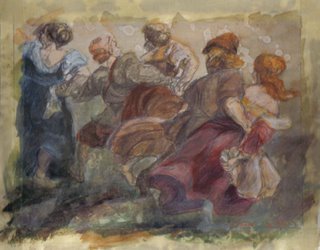Ekphrastic Writing - Writing in Response to Art
In ekphrasis, or ekphrastic art, there are initially two imaginations at work—that of the original artist, and that of the respondent through his/her medium. - Jennifer Bosveld

The painting is a creative study of part of a Paul Reuben's painting by Havi
From the moment I saw these people spinning around on Havilah's desk, I was captivated. I bought it from her. Now it sits on my dresser, where every morning I look at it. Something about the movement of the dancer's bodies, the abscence of their faces, invites me. I want to gaze and gaze until time slips away.
Can't you almost hear the music, the sound of their feet thumping the ground? I expect them to turn at any moment. While I look for a glimpse of their faces, I already know the expression there. Doesn't the placement of their limbs tell you? The feirce energy from arm to waist, hand to skirt, foot to floor? Can't you feel the look of breathless joy?
Notice the warm hues of the painting. The muted maroons, golds, and browns, except for the exquisite woman on the far left. The crisp blue fabric of her collar hangs below her shoulders revealing the smooth line of her neck and back, seductive and lovely.
Why is her face the only one we're allowed to glimpse? Even that glimpse is fleeting, shrouded. We see only her profile, the cut of her fine nose, the gentle slope of her chin. And just as the color of her dress sets her apart from the rest of the dancers, so does the expression which sneaks away from her profile. She carries a sublime look, not one of furious fun. A still expression, as if she should be naked and cut from white marble.
This lady in blue is the only dancer without a partner. We imagine a body next to hers, we envision the strong face she is looking into, and yet there is no arm tucked around her waist like the other two women. If the lady in blue is dancing the same dance, if she is in step with the other two couples, shouldn't she be leaning on her partner's arm, ready to spin into the next move? No, she stands alone, leaning back, serenly tilting her chin.
Who is this woman? It is as if the enegery of the painting swirls around her, as if the dancers themselves are being spun from that one hand on her hip, poured into existance as she crosses the room. Is she the genesis of all this mirth? The centerfuge of movement, and rhythm, and fun?
If so, I want to be one of the bodies dropped from her fingers, brought into life in brown and red watercolor. I want to be grabbing my skirts, balanced on the hip of another, swinging round the room with air sweeping beneath my feet.

The painting is a creative study of part of a Paul Reuben's painting by Havi
From the moment I saw these people spinning around on Havilah's desk, I was captivated. I bought it from her. Now it sits on my dresser, where every morning I look at it. Something about the movement of the dancer's bodies, the abscence of their faces, invites me. I want to gaze and gaze until time slips away.
Can't you almost hear the music, the sound of their feet thumping the ground? I expect them to turn at any moment. While I look for a glimpse of their faces, I already know the expression there. Doesn't the placement of their limbs tell you? The feirce energy from arm to waist, hand to skirt, foot to floor? Can't you feel the look of breathless joy?
Notice the warm hues of the painting. The muted maroons, golds, and browns, except for the exquisite woman on the far left. The crisp blue fabric of her collar hangs below her shoulders revealing the smooth line of her neck and back, seductive and lovely.
Why is her face the only one we're allowed to glimpse? Even that glimpse is fleeting, shrouded. We see only her profile, the cut of her fine nose, the gentle slope of her chin. And just as the color of her dress sets her apart from the rest of the dancers, so does the expression which sneaks away from her profile. She carries a sublime look, not one of furious fun. A still expression, as if she should be naked and cut from white marble.
This lady in blue is the only dancer without a partner. We imagine a body next to hers, we envision the strong face she is looking into, and yet there is no arm tucked around her waist like the other two women. If the lady in blue is dancing the same dance, if she is in step with the other two couples, shouldn't she be leaning on her partner's arm, ready to spin into the next move? No, she stands alone, leaning back, serenly tilting her chin.
Who is this woman? It is as if the enegery of the painting swirls around her, as if the dancers themselves are being spun from that one hand on her hip, poured into existance as she crosses the room. Is she the genesis of all this mirth? The centerfuge of movement, and rhythm, and fun?
If so, I want to be one of the bodies dropped from her fingers, brought into life in brown and red watercolor. I want to be grabbing my skirts, balanced on the hip of another, swinging round the room with air sweeping beneath my feet.


2 Comments:
Beautiful Tin!
Dad
Havi is such a talented artist! Thanks for sharing your thoughts!
Post a Comment
Subscribe to Post Comments [Atom]
<< Home